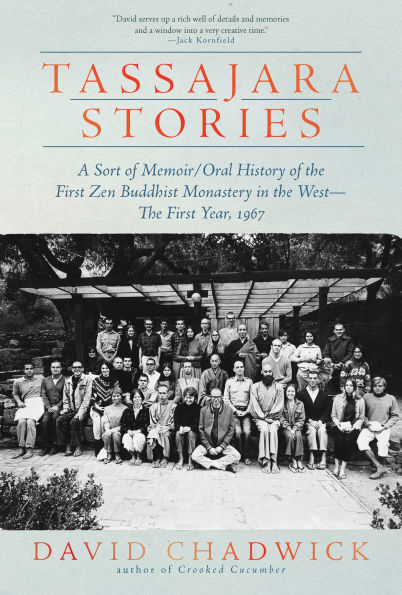I have great respect for David Chadwick. He is one of the pioneers spreading dharma in the West. All my students study his books. I know all readers will love this book and these stories.” —Natalie Goldberg, author of Writing Down the Bones
“Two in three Americans today say they are ‘spiritual,’ while one in four identifies as ‘spiritual but not religious.’ For full immersion in one of the deepest well-springs of this widespread cultural revolution, dive into these stories of free spirits and seekers creating a uniquely western monastic community rooted in centuries of Zen Buddhist practice and led by a teacher true to the moment. No one tells it better than David Chadwick, with a firsthand feel for the high adventure and deep play of mind-changing history embodied in the making.” —Steven M. Tipton, author of In and Out of Church: The Moral Arc of Spiritual Change in America
“For those who care about the genesis of Tassajara and Zen in America, this is a fun read. David serves up a rich well of details and memories and a window into a very creative time.” —Jack Kornfield, author of A Path With Heart
“This book is as priceless as discovering a previously unknown time capsule. David Chadwick, widely known as one of Suzuki Roshi’s favorites, captures the wacky spirit, the dedication, and the courage required to leap into the unknown that characterized the earliest Zen students surrounding Suzuki Roshi. (Full disclosure: David became one of my earliest friends when I began my practice in 1974.) Fifty-one years later, an ordained priest and transmitted teacher, I still look up to David as an original member of the A-team. This book, in his authentic and unduplicable voice, is an absolute treasure. Read it. Give a copy to a friend.” —Peter Coyote (Hosho Jishi), actor, director, author
“I had a good time reading Tassajara Stories and hoped they would never end. Just as you can’t learn Zen from a book, you can’t really know the Tassajara experience even through this amazing memoir. But you can get caught up in it, especially when it is written with such immediacy and love as David Chadwick has done it. There are valuable lessons galore and more colorful personalities that you could ever hope to find in a faraway haven in the enchanting but haunted woods.” —Thomas Moore, author of Care of the Soul
“An engrossing account of the people and antics that defined the Tassajara monastery in 1967.” —Kirkus Reviews
“David Chadwick’s latest book on the expansion of Buddhism in America—Tassajara Stories: A Sort of Memoir/Oral History of the First Zen Buddhist Monastery in the West—The First Year, 1967—takes readers back to the early days of the monastery founded by Buddhis master Shunryu Suzuki in a mountainous California forest…. [H]e introduces people who hammered the Tassajara facility together, baked the bread, meditated, mediated, and created ‘a community and a commune’ where they could study and practice.” —Cathy Lynn Grossman, Publishers Weekly, July 8, 2025
2025-04-23
This nonfiction collection of stories focuses on people who spent time at a Zen Buddhist monastery in California in the first year of its founding.
Chadwick recounts memories—both his own and others’ recollections gathered via sources like interviews, emails, and podcasts—from the first year of Tassajara, the first Zen monastery in the West. The Carmel Valley monastery was founded in 1967 by Shunryu Suzuki, the abbot of the San Francisco Zen Center, and subsequently witnessed a revolving door of people looking for inspiration, enlightenment, or simply an alternative way of living for a while. The author walks readers through the minutiae of daily life at the monastery, which included a “complex oryoki eating ritual and chanting, which dragged the meal out to an hour with little time for the actual eating.” He also recalls various anecdotes and visitors, explaining different phrases and terminology along the way (“Kobun wore a black monastic work outfit he calledsamue. Samu was monastic work and ‘e’ meant clothes”). While the stories largely unfold chronologically, there is no particular thread to connect them other than their shared time and place. Chadwick uses short, choppy sentences with minimal adornment, creating a strange sense of monotony—but one that is occasionally broken up by a beautiful description of nature or a particularly memorable event. One such highlight is when the poets Allen Ginsberg, Lawrence Ferlinghetti, and Daniel Moore came to meditate, read verse, sing, and chant mantras. This performance sparks what is surely one of the more delightfully bizarre sentences ever written: “Ginsberg played his harmonium with Ferlinghetti and Moore on Chinese horn and Hindu bells.” Surprisingly (and a bit disappointingly), the book’s focus consistently remains on the physical details of Tassajara and the everyday actions of its inhabitants, with very little personal or spiritual introspection. Still, the thorough and enlightening work achieves its ultimate goal of being an “oral history” by providing unparalleled access to daily life in a remarkable time and place.
An engrossing account of the people and antics that defined the Tassajara monastery in 1967.



